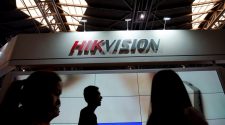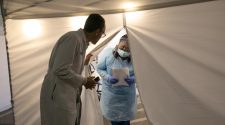DUBLIN, June 16, 2021 /PRNewswire/ — The “LiDAR Sensor For Environmental Market By Technology, Installation Type, Service and Application: Global Opportunity Analysis and Industry Forecast, 2020-2027” report has been added to ResearchAndMarkets.com’s offering.
The global LiDAR sensor for environmental market size was valued at $249.3 million in 2019, and is projected to reach $653.8 million by 2027, to register a CAGR of 15.1% from 2020 to 2027. Light detection and ranging (LiDAR) system was introduced to enable examination, detection, and mapping of objects using light rays. Basic LiDAR device consists of a sender, which emits light rays and a receiver used to capture reflected light rays for mapping. This system has witnessed increase in adoption over conventional surveying methods, owing to its ability to provide highly accurate data and 3D images in a shorter time.
Improvements in automated processing ability of LiDAR systems, In termss of image resolution, and prompt data processing capability over other technologies are the major factors that drive growth of the global LiDAR sensor for environmental market. Other factors that supplement growth of the LiDAR sensor for environmental market include rise in demand for 3D imaging technology across various application areas and increase in adoption of aerial LiDAR systems to explore and detect places and historic details.
However, less awareness about benefits of LiDAR systems and use of expensive components in these systems, such as laser scanner, navigation system, and high-resolution 3D cameras, collectively increase the cost of LiDAR systems. Hence, these factors limit adoption of LiDAR sensor systems. Furthermore, increase in need for LiDAR-captured data in newer applications and emergence of 4D LiDAR creates numerous growth opportunities for the market growth.
Furthermore, players in the market have adopted product launch and collaborations as their key developmental strategies to meet customer demands and increase their customer base. Partnerships are likely to help players set a common technology platform and share technological requirements. This is expected to help market players to enhance their product portfolio in less investments and increase their market share across various regions.
The global LiDAR sensor for environmental market is segmented on the basis of technology, installation, service, application, and region. On the basis of technology, the market is divided into 2D LiDAR, 3D LiDAR, and 4D LiDAR. By installation, the market is bifurcated into airborne LiDAR and ground-based LiDAR. On the basis of service, it is divided into aerial surveying and ground-based surveying. On the basis of application, it is divided into forest management, coastline management, air pollution, water pollution, agriculture, and others. Region wise, the market is analyzed across North America, Europe, Asia-Pacific, and LAMEA.
The company profiles of LiDAR sensor for environmental market players included in this report are Faro Technologies Inc., Geodetics, Leica Geosystems AG, MeaTech (Measurement Technologies) solutions LLP, Mitsubishi Electric Corporation, RIEGL, Sick AG, Topcon Positioning Group, Trimble Inc., and Vaisala.
Key Topics Covered:
CHAPTER 1: INTRODUCTION
CHAPTER 2: EXECUTIVE SUMMARY
2.1. CXO perspective50
CHAPTER 3: MARKET OVERVIEW
3.1. Market definition and scope
3.2. Key findings
3.2.1. Top investment pockets
3.2.2. Top Winning Strategies
3.3. Porter’s five forces analysis
3.4. Market share analysis, 2019
3.5. Market dynamics
3.5.1. Drivers
3.5.1.1. Automated processing in LiDAR systems
3.5.1.2. Enhanced performance of LiDAR systems than other technologies
3.5.1.3. Rise in demand for 3D imaging
3.5.1.4. Surge in need for aerial LiDAR
3.5.2. Restraints
3.5.2.1. Lack of awareness
3.5.3. Opportunities
3.5.3.1. Increase in need for LiDAR-captured data in newer applications
3.5.3.2. Emergence of 4D LiDAR
3.6. COVID-19 Impact Analysis
3.6.1. Impact on market size
3.6.2. Industry vertical trends, preferences, and budget impact
3.6.3. Key player strategies to tackle COVID-19 impact
CHAPTER 4: LIDAR SENSOR FOR ENVIRONMENTAL MARKET,
BY TECHNOLOGY
4.1. Overview
4.2.2D LIDAR
4.2.1. Key market trends, growth factors, and opportunities
4.2.2. Market size and forecast, by region
4.2.3. Market analysis, by country
4.3.3D LIDAR
4.3.1. Key market trends, growth factors, and opportunities
4.3.2. Market size and forecast, by region
4.3.3. Market analysis, by country
4.4.4D LIDAR
CHAPTER 5: LIDAR SENSOR FOR ENVIRONMENTAL MARKET,
BY INSTALLATION TYPE
5.1. Overview
5.2. Airborne LIDAR
5.2.1. Key market trends, growth factors, and opportunities
5.2.2. Market size and forecast, by region
5.2.3. Market analysis, by country
5.3. Ground based LIDAR
5.3.1. Key market trends, growth factors, and opportunities
5.3.2. Market size and forecast, by region
5.3.3. Market analysis, by country
CHAPTER 6: LIDAR SENSOR FOR ENVIRONMENTAL MARKET, BY SERVICE
6.1. Overview
6.2. Aerial surveying
6.2.1. Key market trends, growth factors, and opportunities
6.2.2. Market size and forecast, by region
6.2.3. Market analysis, by country
6.3. Ground based surveying
6.3.1. Key market trends, growth factors, and opportunities
6.3.2. Market size and forecast, by region
6.3.3. Market analysis, by country
CHAPTER 7: LIDAR SENSOR FOR ENVIRONMENTAL MARKET,
BY APPLICATION
7.1. Overview
7.2. Forest management
7.2.1. Key market trends, growth factors, and opportunities
7.2.2. Market size and forecast, by region
7.2.3. Market analysis, by country
7.3. Coastline management
7.3.1. Key market trends, growth factors, and opportunities
7.3.2. Market size and forecast, by region
7.3.3. Market analysis, by country
7.4. Air pollution
7.4.1. Key market trends, growth factors, and opportunities
7.4.2. Market size and forecast, by region
7.4.3. Market analysis, by country
7.5. Water pollution
7.5.1. Key market trends, growth factors, and opportunities
7.5.2. Market size and forecast, by region
7.5.3. Market analysis, by country
7.6. Agriculture
7.6.1. Key market trends, growth factors, and opportunities
7.6.2. Market size and forecast, by region
7.6.3. Market analysis, by country
7.7. Others
7.7.1. Floods
7.7.2. Landslides
7.7.3. Torrential rains
7.7.4. Market size and forecast, by region
7.7.5. Market analysis, by country
CHAPTER 8: LIDAR SENSOR FOR ENVIRONMENTAL MARKET, BY REGION
CHAPTER 9: COMPANY PROFILES
9.1. FARO TECHNOLOGIES INC.
9.1.1. Company overview
9.1.2. Key Executives
9.1.3. Company snapshot
9.1.4. Operating business segments
9.1.5. Product portfolio
9.1.6. R&D Expenditure
9.1.7. Business performance
9.1.8. Key strategic moves and developments
9.2. GEODETICS
9.2.1. Company overview
9.2.2. Key Executives
9.2.3. Company snapshot
9.2.4. Operating business segments
9.2.5. Product portfolio
9.2.6. Key strategic moves and developments
9.3. LEICA GEOSYSTEMS AG
9.3.1. Company overview
9.3.2. Key Executives
9.3.3. Company snapshot
9.3.4. Operating business segments
9.3.5. Product portfolio
9.3.6. R&D Expenditure
9.3.7. Business performance
9.3.8. Key strategic moves and developments
9.4. MEATECH SOLUTIONS LLP
9.4.1. Company overview
9.4.2. Key Executives
9.4.3. Company snapshot
9.4.4. Operating business segments
9.4.5. Product portfolio
9.5. MITSUBISHI ELECTRIC CORPORATION
9.5.1. Company overview
9.5.2. Key Executives
9.5.3. Company snapshot
9.5.4. Operating business segments
9.5.5. Product portfolio
9.5.6. R&D Expenditure
9.5.7. Business performance
9.5.8. Key strategic moves and developments
9.6. RIEGL
9.6.1. Company overview
9.6.2. Key Executives
9.6.3. Company snapshot
9.6.4. Operating business segments
9.6.5. Product portfolio
9.6.6. Key strategic moves and developments
9.7. SICK AG
9.7.1. Company overview
9.7.2. Key Executives
9.7.3. Company snapshot
9.7.4. Operating business segments
9.7.5. Product portfolio
9.7.6. R&D Expenditure
9.7.7. Business performance
9.7.8. Key strategic moves and developments
9.8. TOPCON POSITIONING GROUP
9.8.1. Company overview
9.8.2. Key Executives
9.8.3. Company snapshot
9.8.4. Operating business segments
9.8.5. Product portfolio
9.8.6. R&D Expenditure
9.8.7. Business performance
9.8.8. Key strategic moves and developments
9.9. VAISALA
9.9.1. Company overview
9.9.2. Key Executives
9.9.3. Company snapshot
9.9.4. Operating business segments
9.9.5. Product portfolio
9.9.6. R&D Expenditure
9.9.7. Business performance
9.9.8. Key strategic moves and developments
9.10. VELODYNE LIDAR, INC.
9.10.1. Company overview
9.10.2. Key Executives
9.10.3. Company snapshot
9.10.4. Operating business segments
9.10.5. Product portfolio
9.10.6. R&D Expenditure
9.10.7. Business performance
9.10.8. Key strategic moves and developments
9.11. TRIMBLE INC.
9.11.1. Company overview
9.11.2. Key Executives
9.11.3. Company snapshot
9.11.4. Operating business segments
9.11.5. Product portfolio
9.11.6. R&D Expenditure
9.11.7. Business performance
9.11.8. Key strategic moves and developments
For more information about this report visit https://www.researchandmarkets.com/r/atzscg
Media Contact:
Research and Markets
Laura Wood, Senior Manager
[email protected]
For E.S.T Office Hours Call +1-917-300-0470
For U.S./CAN Toll Free Call +1-800-526-8630
For GMT Office Hours Call +353-1-416-8900
U.S. Fax: 646-607-1904
Fax (outside U.S.): +353-1-481-1716
SOURCE Research and Markets
Related Links
http://www.researchandmarkets.com














